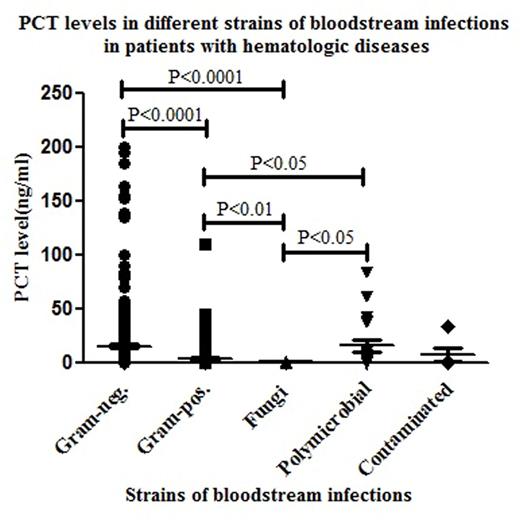Abstract
High procalcitonin (PCT) levels are strongly associated with systemic bacterial infections. PCT is produced in response to bacterial endotoxin and inflammatory cytokines. Few studies are available in the literature on PCT ability to distinguish different strains of bloodstream infections in patients with hematologic diseases. The aim of the present study was to explore the value of determining serum PCT values early, i.e., as soon as blood cultures are positive, in a large population of patients with hematologic diseases.
Patients with hematologic diseases admitted to the hematology department of our hospitalfrom January 2013 to March 2016 who had bloodstream infections were retrospectively analyzed. Patients whose blood samples were collected for simultaneous blood culture and PCT test were enrolled in the study, and they were divided into agranulocytosis and non-agranulocytosis groups. Automatic microbial analyzer was used to identify all strains, and PCT levels were analyzed with an automatic electrochemiluminescence system. The relationship between PCT levels and the strains in bloodstream infections was analyzed and compared, and the diagnostic efficacy of PCT was evaluated using the receiver operating characteristic (ROC) curve.
A total of 494 bloodstream infection cases that fulfilled the inclusion criteria were included in the study, involving 312 cases of bloodstream infection with single Gram-negative, 146 cases with single Gram-positive, 12 cases with single fungi, 19 cases with polymicrobes, and 5 cases identified as contaminated specimens. Unpaired t-test was used for data analysis. PCT levels for single Gram-negative infection (15.17±2.11 ng/ml) were significantly higher than those for Gram-positive infection (3.30 ± 0.93 ng/ml) (P<0.0001), or those for single fungi infection (0.22 ± 0.04 ng/ml) (P<0.0001). PCT levels for single Gram-positive infection were also significantly higher than those in single fungi infection (P<0.01).
In the agranulocytosis group, which included 403 cases, the PCT levels in the single Gram-negative infection (14.14 ± 2.13 ng/ml) were significantly higher than those in single Gram-positive (2.49 ± 0.73 ng/ml) (P<0.0001), or in single fungi infection (0.24 ± 0.04 ng/ml) (P<0.0001). The PCT levels in the single Gram-positive bacterial infection were also significantly higher than those in single fungi infection (P<0.01). In the single Gram-negative bacteria bloodstream infection, we further found that the PCT levels in Enterobacteriaceae infection (17.00 ± 3.04 ng/ml) were significantly higher than those in nonfermentative Gram-negatives infection (6.49 ± 1.50 ng/ml) (P<0.01). ROC analysis was performed on monomicrobial blood cultures. ROC of single Gram-negative and Gram-positive infections revealed that the area under the curve (AUC) was 0.687, the best cut-off value was 0.58 ng/ml, the sensitivity was 60.81% and specificity was 71%. ROC of single Gram-negative and fungi infections revealed that the AUC was 0.795, the best cut-off value was 0.42 ng/ml, the sensitivity was 67% and specificity was 100%. ROC of single Gram-positive and fungi infections revealed that the AUC was 0.6, the best cut-off value was 0.44 ng/ml, the sensitivity was 37% and specificity was 100%.
In the non-agranulocytosis group, we only found that the PCT levels in the single Gram-negative infection were significantly higher than those in single Gram-positive infection (P<0.05).
In summary, early serum PCT quantitative determination can be used as a routine test to help to distinguish Gram-negative bacteria, Gram-positive bacteria, or fungi bloodstream infections in patients with hematologic diseases. These findings will be of great clinical value to select appropriate antibiotics for patients with hematologic diseases and bloodstream infections.
No relevant conflicts of interest to declare.
Author notes
Asterisk with author names denotes non-ASH members.


This feature is available to Subscribers Only
Sign In or Create an Account Close Modal